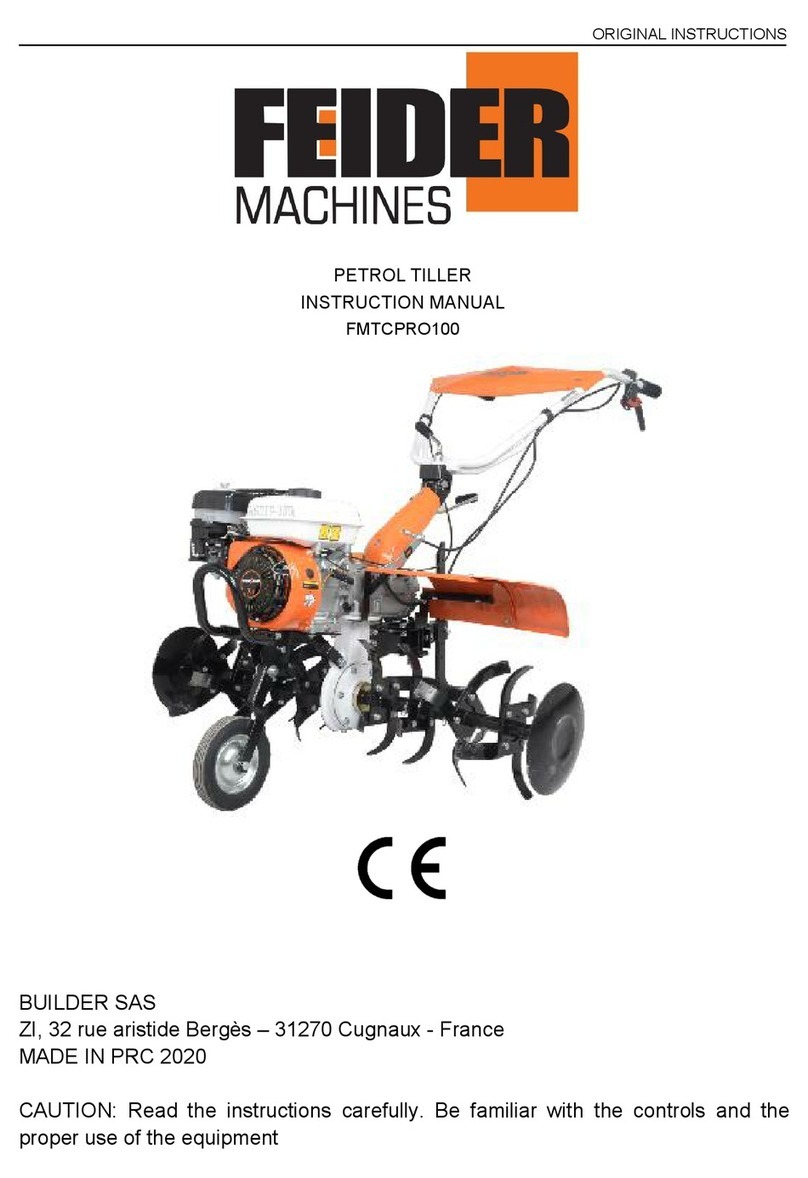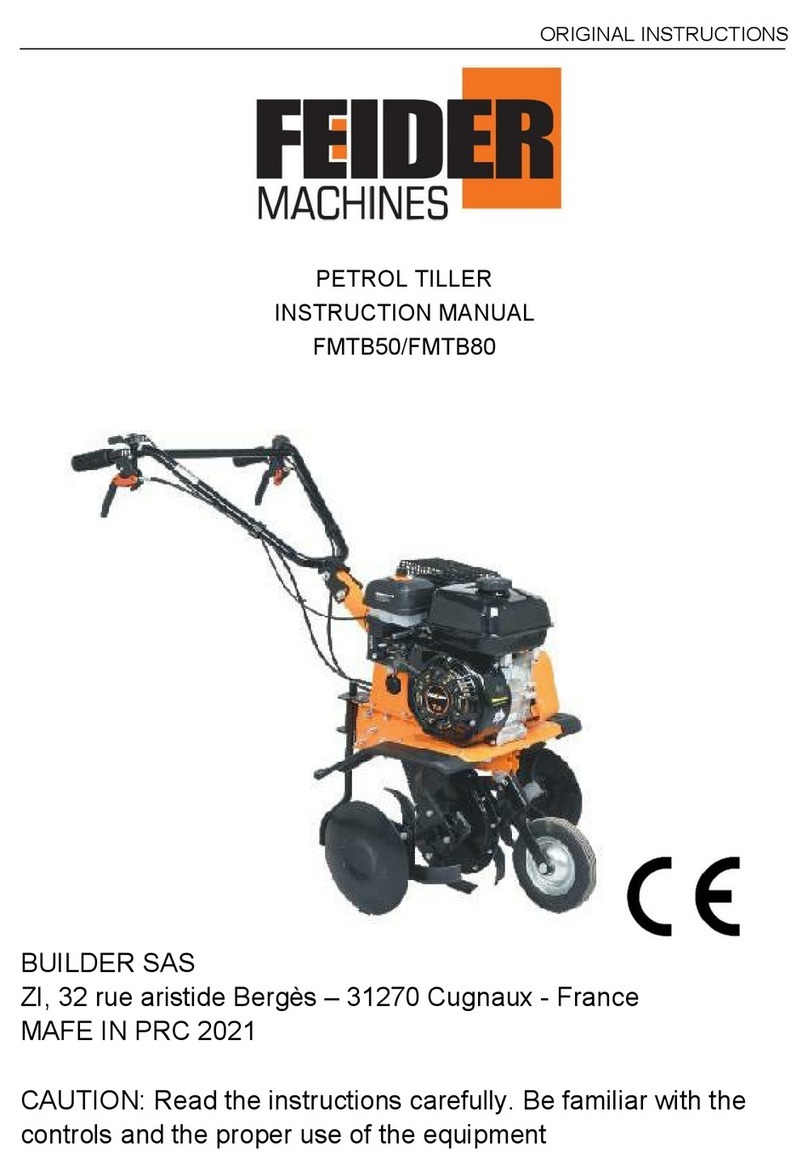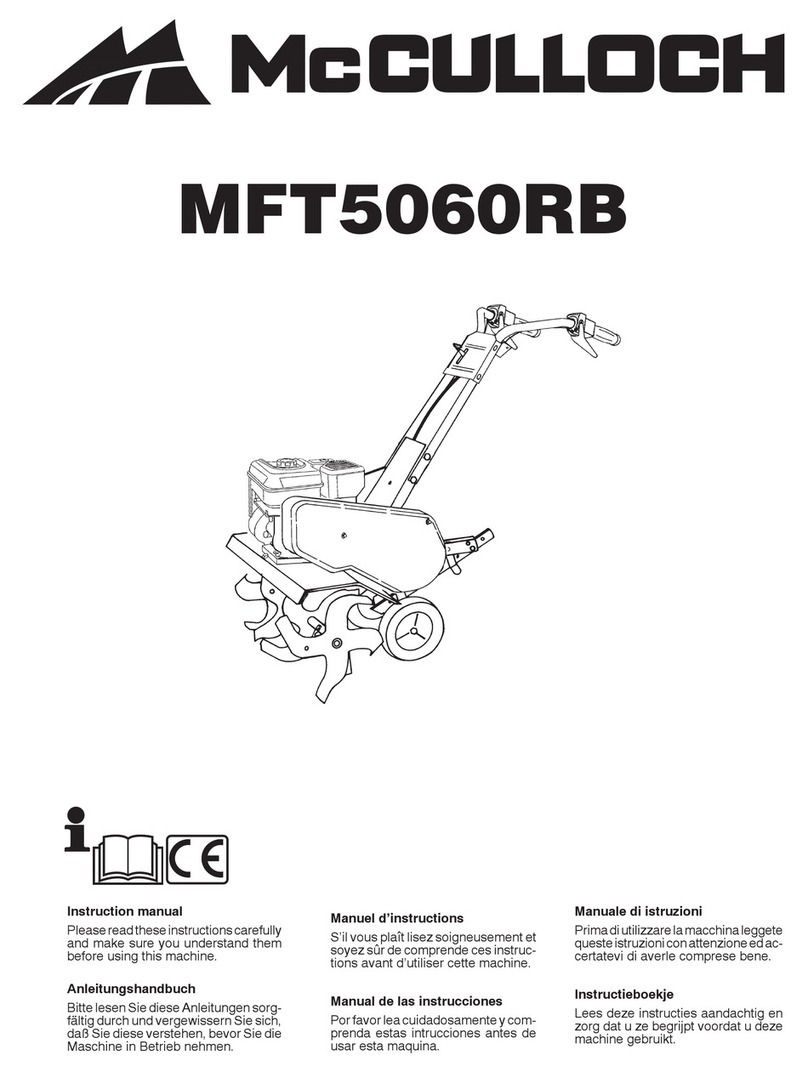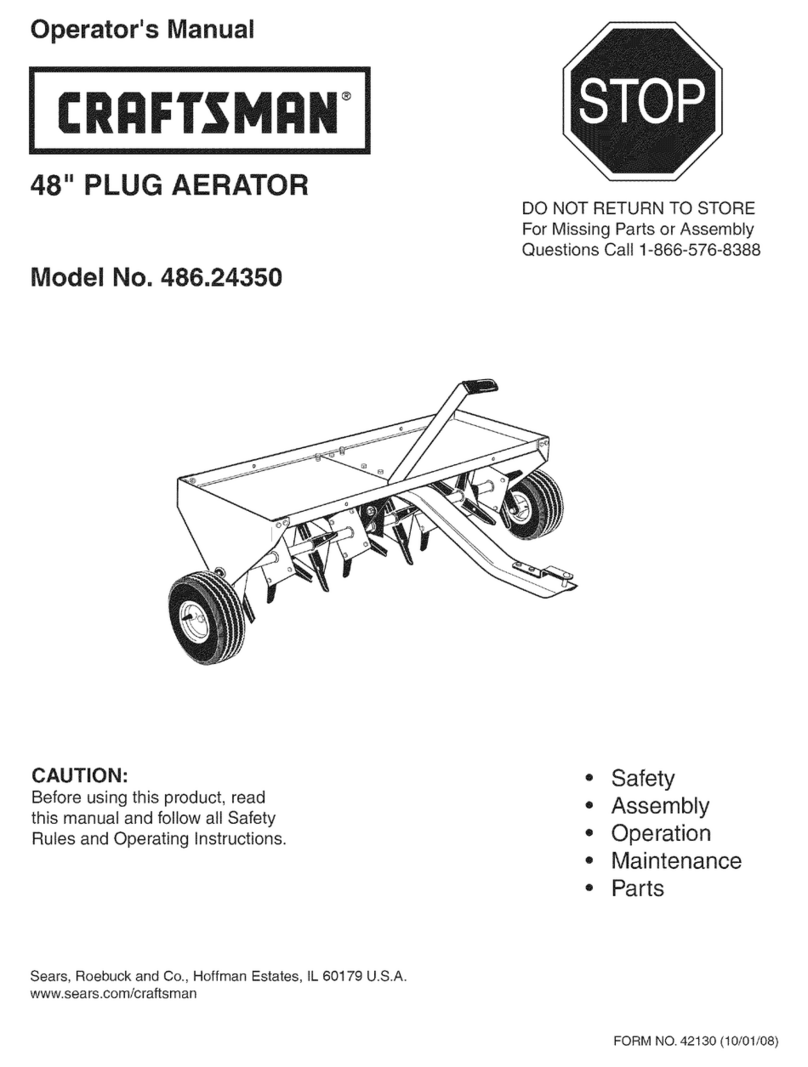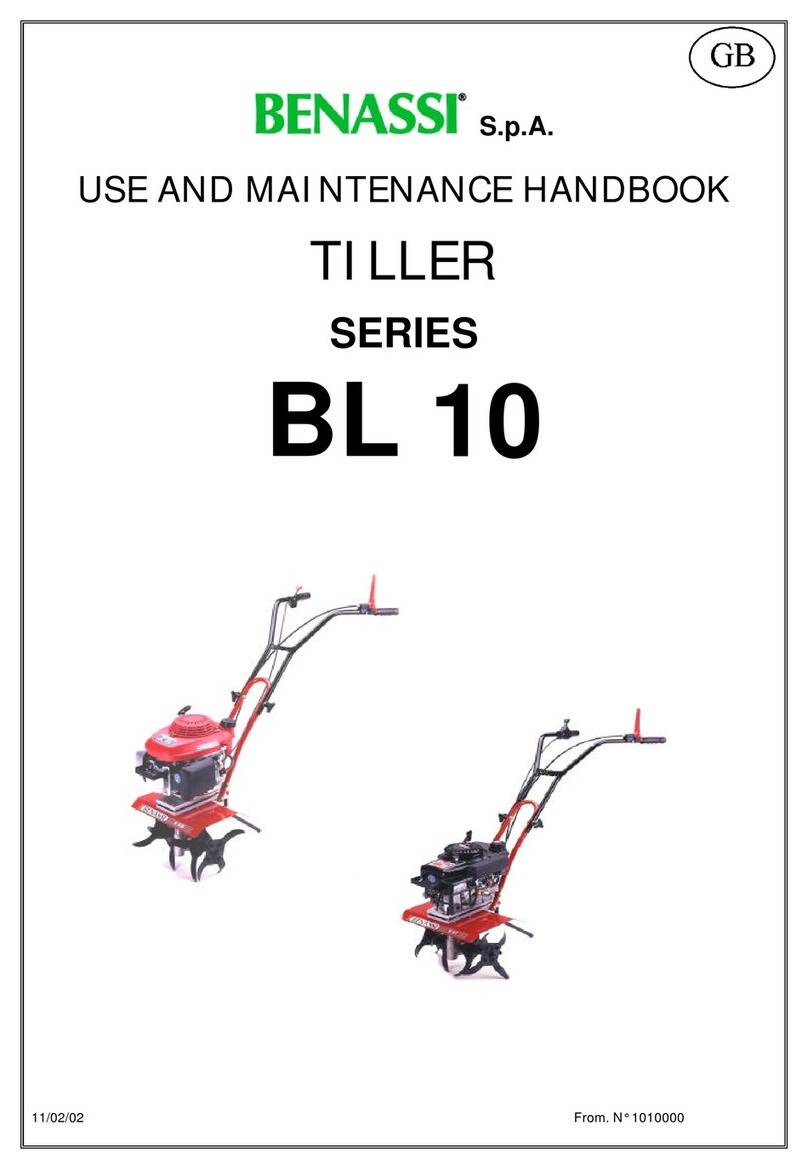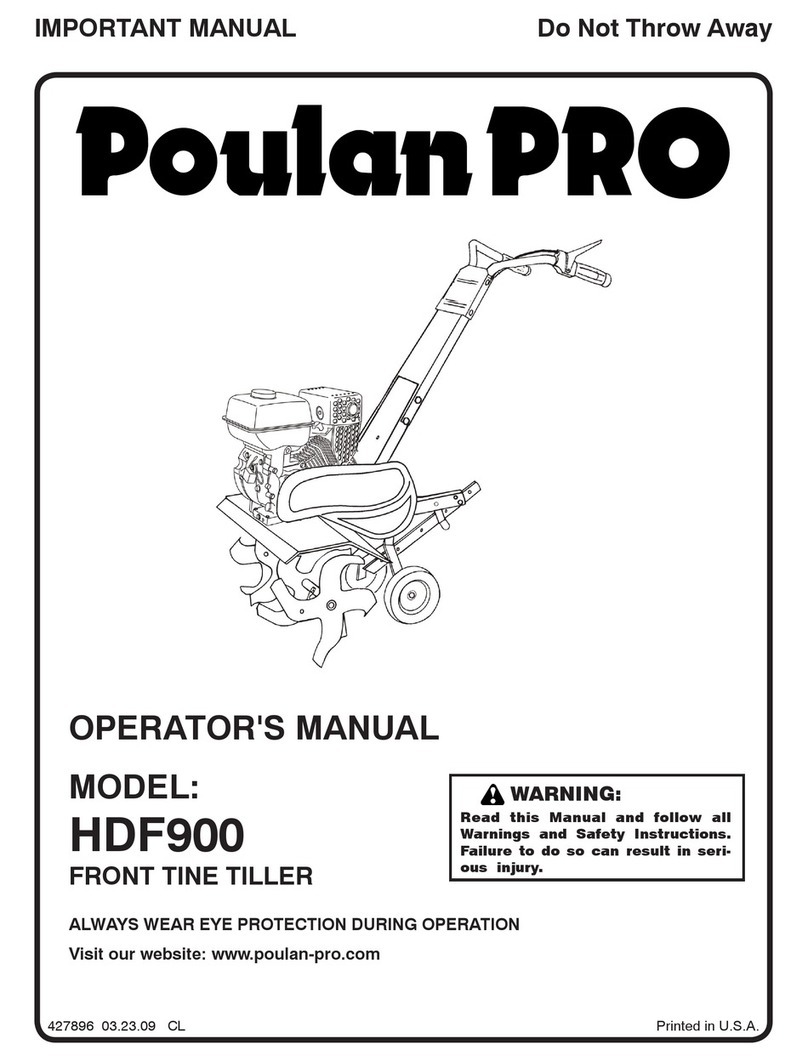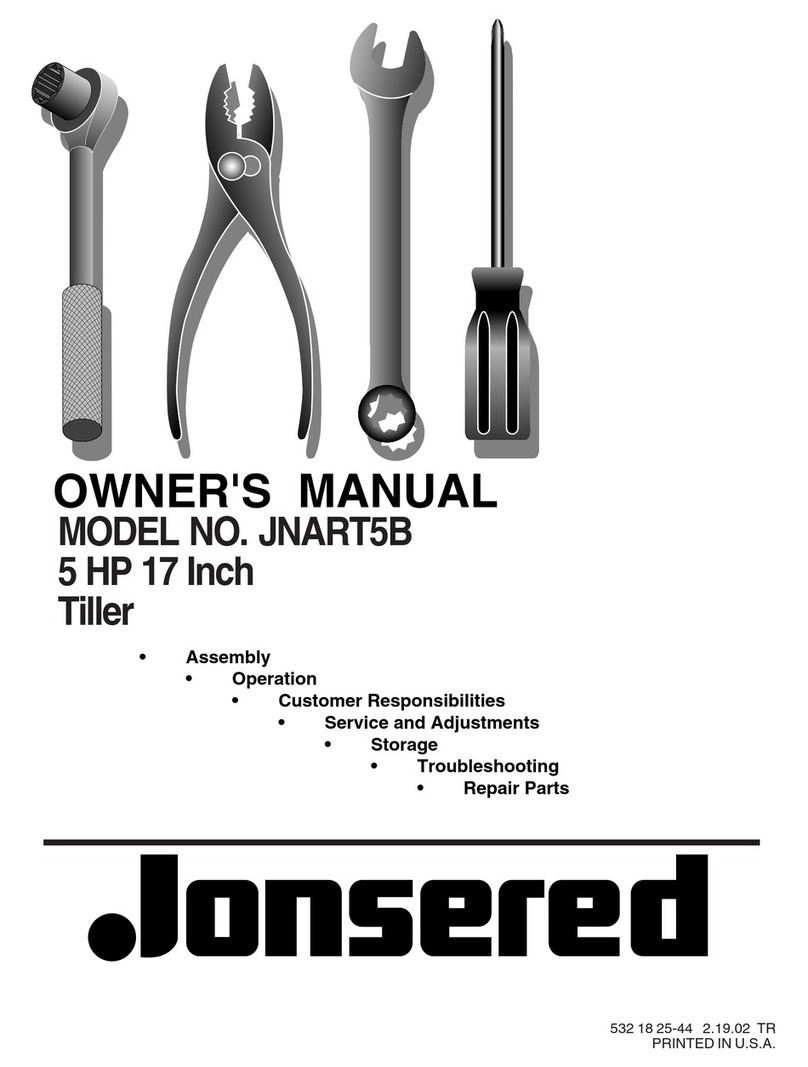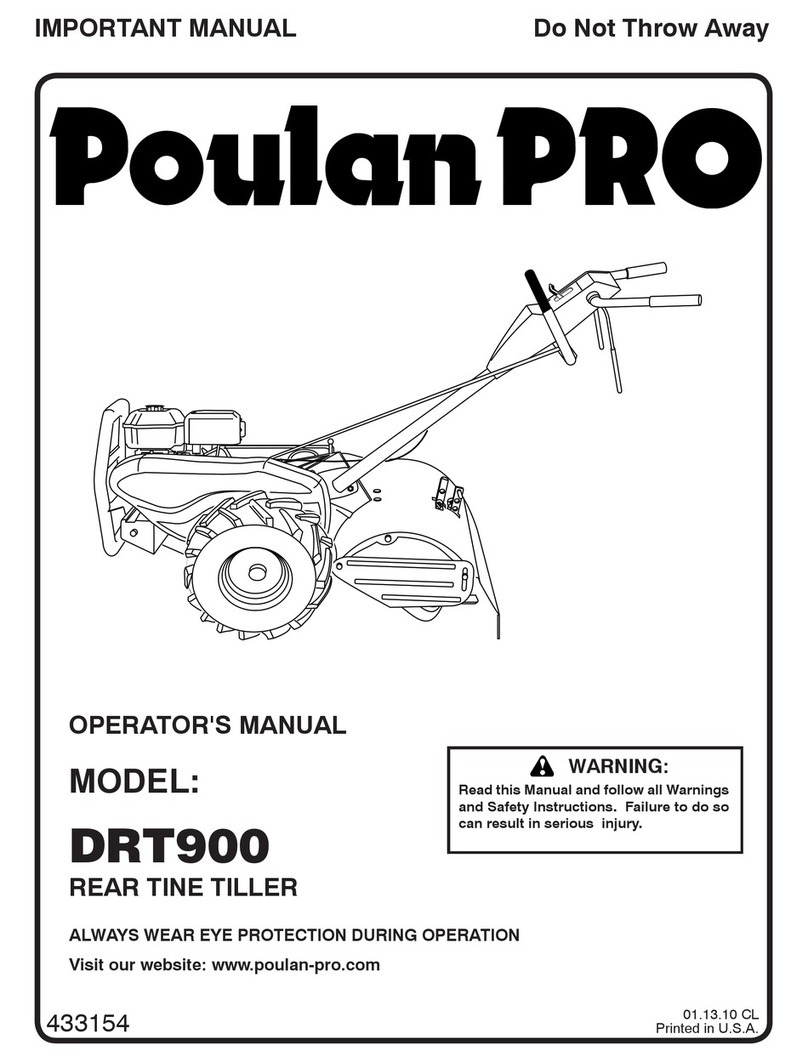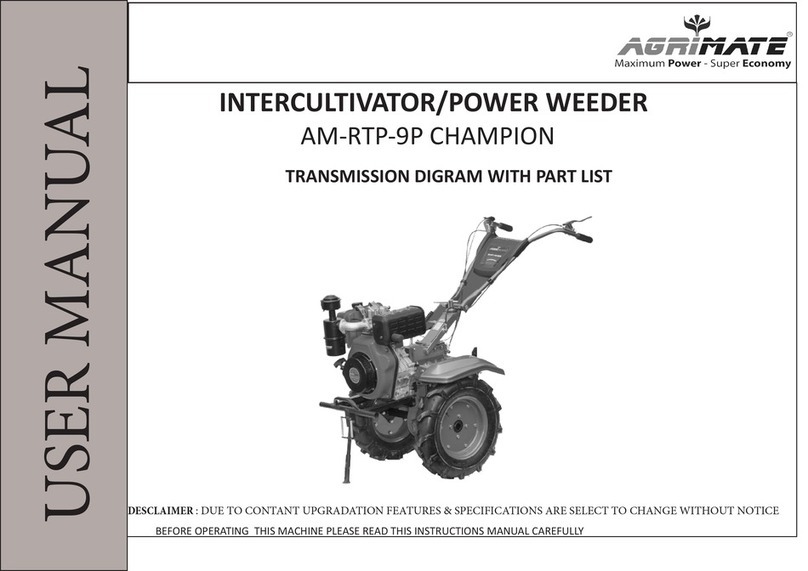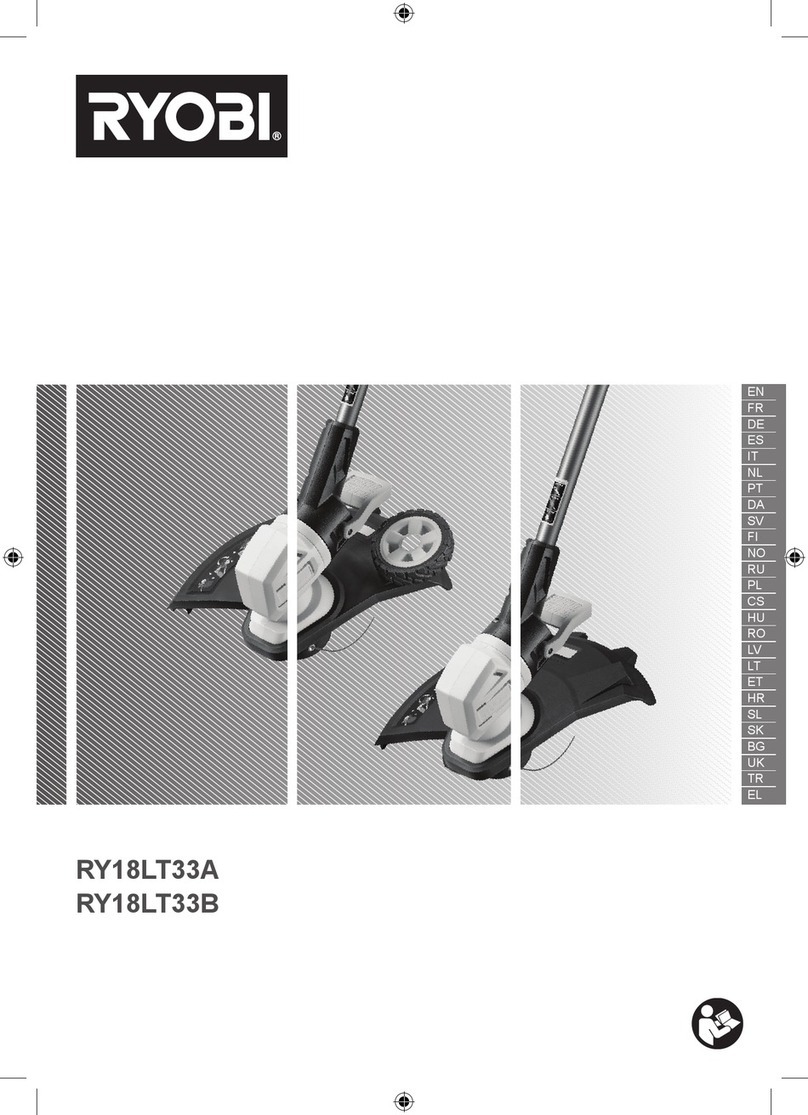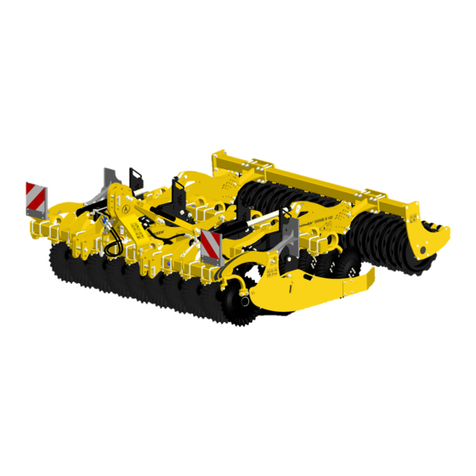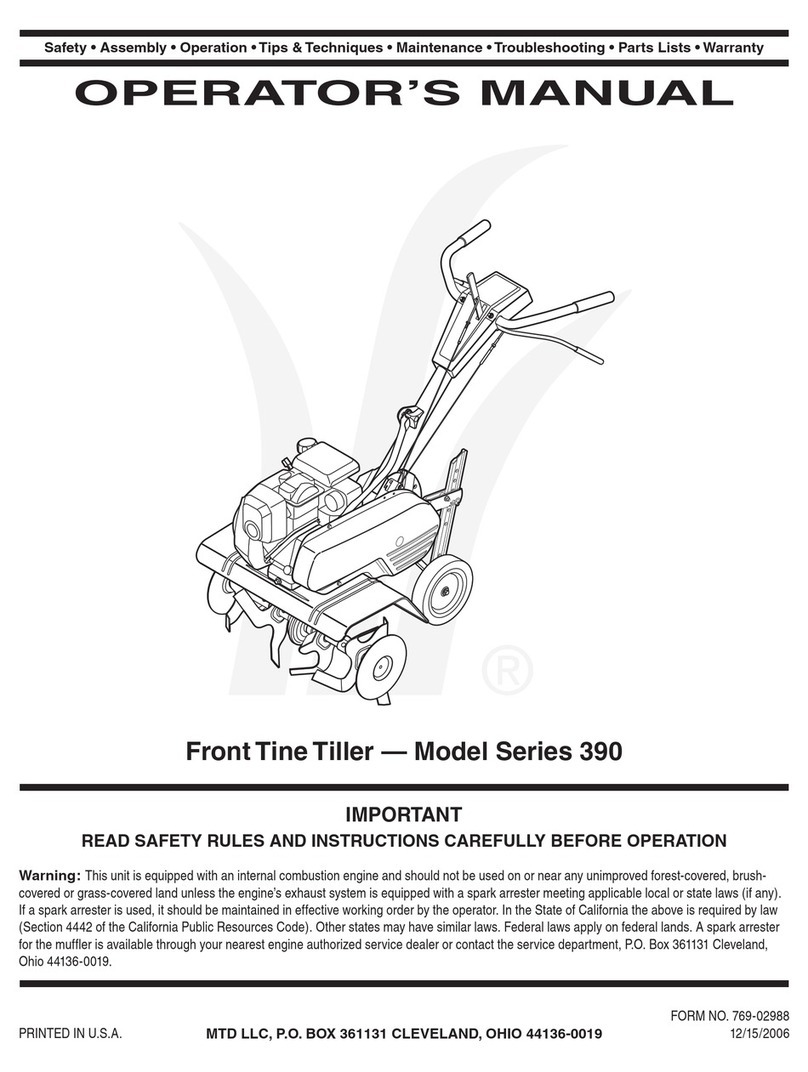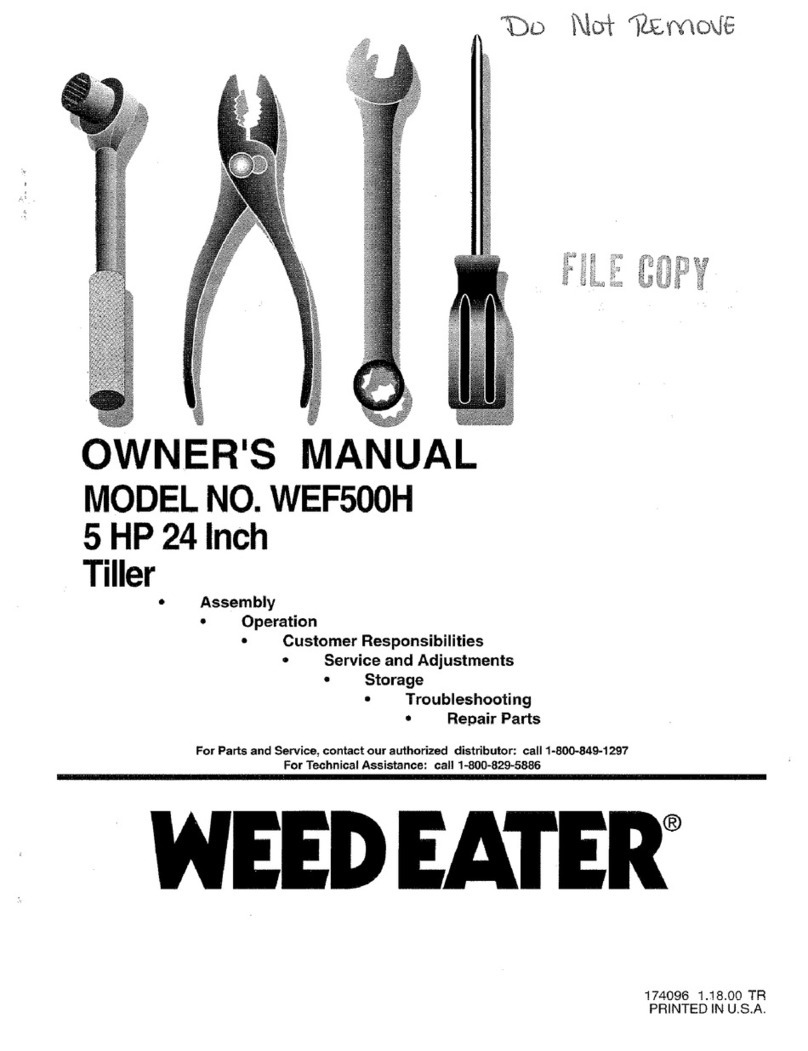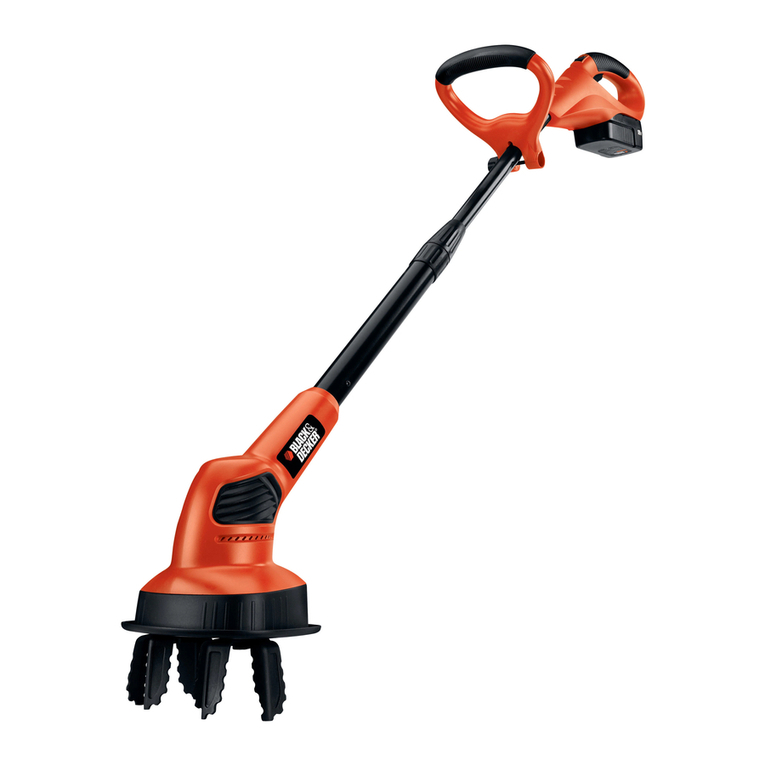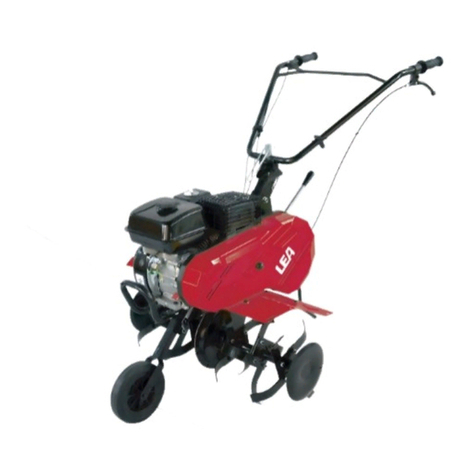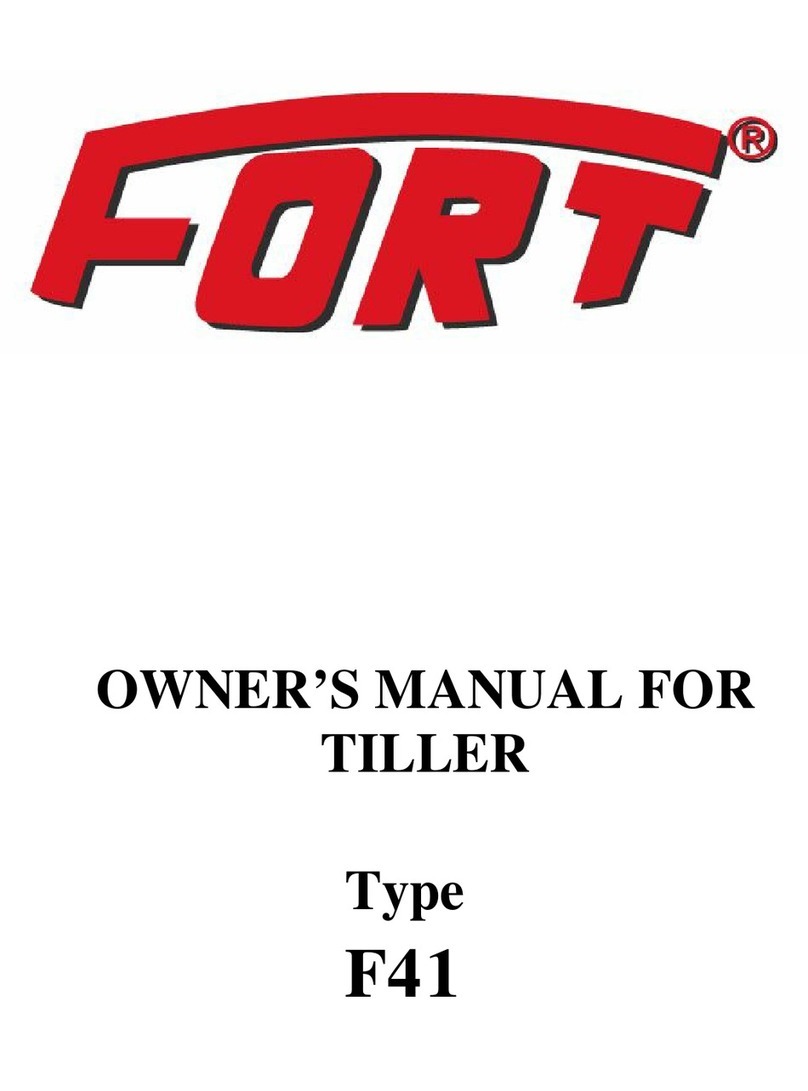Feider Machines FMTC100 User manual

ORIGINAL INSTRUCTIONS
PETROL TILLER
INSTRUCTION MANUAL
FMTC100
BUILDER SAS
ZI, 32 rue aristide Bergès – 31270 Cugnaux - France
MAFE IN PRC 2020
CAUTION: Read the instructions carefully. Be familiar with the
controls and the proper use of the equipment

1. SAFETY WARNING:
For your safety and safety of others please pay special attention to these
precautions:
1) Training
a) Read the instructions carefully. Be familiar with the controls and the
proper use of the equipment;
b) Never allow children or people unfamiliar with these instructions to use
the machine. Local regulations can restrict the age of the operator;
c) Never work while people, especially children, or pets are nearby;
d) Keep in mind that the operator or user is responsible for accidents or
hazards occurring to other people or their property.
2) Preparation
a) While working, always wear substantial footwear and long trousers. Do
not operate the equipment when barefoot or wearing open sandals;
b) Thoroughly inspect the area where the equipment is to be used and
remove all objects which can be thrown up by the machine;
c) WARNING – Petrol is highly flammable:
Store fuel in containers specifically designed for this purpose;
Refuel outdoors only and do not smoke while refuelling;
Add fuel before starting the engine. Never remove the cap of the
fuel tank or add petrol while the engine is running or when the
engine is hot;
If petrol is spilled, do not attempt to start the engine but move the
machine away from the area of spillage and avoid creating any
source of ignition until petrol vapours have dissipated;
Replace all fuel tank and container caps securely;
d) Replace faulty silencers;
e) Before using, always visually inspect to see that the tools are not worn
out or damaged. Replace worn out or damaged elements and bolts in sets
to preserve balance.
3) Operation
a) Do not operate the engine in a confined space where dangerous carbon
monoxide fumes can collect;

b) Work only in daylight or in good artificial light;
c) Always be sure of your footing on slopes;
d) Walk, never run with the machine;
e) For wheeled rotary machines, work across the slopes, never up and
down;
f) Exercise extreme caution when changing direction on slopes;
g) Do not work on excessively steep slopes;
h) Use extreme caution when reversing or pulling the machine towards you;
i) Do not change the engine governor settings or overspeed the engine;
j) Start the engine carefully according to manufacturer instructions and with
feet well away from the tool(s);
k) Do not put your hands or feet near or under rotating parts;
l) Never pick up or carry a machine while the engine is running;
m) Stop the engine:
Whenever you leave the machine;
Before refuelling;
n) Reduce the throttle setting during engine shut down and, if the engine is
provided with a shut-off valve, turn the fuel off at the conclusion of working;
4) Maintenance and storage
a) Keep all nuts, bolts and screws tight to ensure the equipment is in safe
working condition;
b) Never store the equipment with petrol in the tank inside a building where
fumes can reach an open flame or spark;
c) Allow the engine to cool before storing in any enclosure;
d) To reduce the fire hazard, keep the engine, silencer, battery
compartment and petrol storage area free of vegetative material and
excessive grease;
e) Replace worn or damaged parts for safety;
f) If the fuel tank has to be drained, this shall be done outdoors.
Thrown Object Hazard
Objects hit by the rotating tines can be thrown from the tiller with great force
and may cause severe injury.
1) Before tilling, clear the tilling area of sticks, large stones, wire, glass

etc.
2) Pieces thrown from worn or damaged-tines can cause serious injury.
Always inspect the tines before using the tiller.
Fire and Burn Hazard
Gasoline is extremely flammable and gasoline vapor can explode.
Use extreme care when handing gasoline. Keep gasoline out of reach of
children.
1) Refuel in a well-ventilated area with the engine stopped.
2) Allow the engine to cool before refueling. Fuel vapor or spilled fuel
may be ignited.
3) The engine and exhaust system becomes very hot during
operation and remains hot after stopping. Touching them can cause burn
injuries or some materials burn.
4) Avoid touching a hot engine or exhaust system.
5) Allow the engine to cool before performing maintenance or storing
the tiller indoors.
Carbon Monoxide Poisoning Hazard
Exhaust contains poisonous carbon monoxide a colorless and odorless gas.
Breathing exhaust can cause loss of consciousness and may lead to death.
Operation on Slope
1) When tilling on slopes, keep the fuel tank with less than half oil to
minimize fuel spillage.
2) When the tiller walks across the slope, put your effort evenly while
walking up and down the slope.
3) Be very careful when changing the direction of the tiller on a
slope.
4) Do not use the tiller on a slope of more than 10°.
5) The maximum safe grade angle shown is for reference only and
the details should depend on the type of the tool. Before starting the engine,
check that the tiller is not damaged and in good condition. For your safety
or safety of others, pay special attention when using the tiller up or down
hill.

2. WARNING SYMBOL
Attention!
Caution: fire risk!
The part is extremely hot! Do not touch!
Read the instruction manual before use
Caution: Do not put your hands in belt when it
running.
Caution: rotating working tool!
Keep away from the machine.
Warning: Exhaust emissions are harmful to
health of body.
Add engine oil.

That the machine shall always be used in accordance with these
manufacturer's instructions the instruction handbook
The engine shall be stopped when carrying out maintenance and
cleaning operations, when changing tools and when being transported
by means other than under its own power;
Some hazards can be met when working on slopes; work slowly by
holding firmly the tool. Do not transport the tool on slopes. The hazards
can rise when working on difficult soil (stony, hard, etc.). there is a risk
to hit some objects, sliding, lose control for the machine which will gives
damages. Always inspect the working area before working, and always
watch what you are doing.
The adjustable part of the protective device shall be adjusted to the
working depth of the tool so that only that part of the working tool that
cuts into the soil remains uncovered. This does not apply to motor
hoes.
The machine should only be operated by suitably trained persons.
During the operation of the machine safety shoes should be worn.
Always start up the machine under normal conditions
Intended use
This device is to be used only as an electric hoe for aerating lawns and
grassy areas in private home gardens and pleasure gardens. It is not
intended for use in public spaces, parks, sports fields, agriculture or forestry.
Use of this device for any other purpose is considered incorrect and
unapproved. The manufacturer will not be responsible for any damage or
injury resulting from such use. The user is fully responsible for all related
risks.

ORIGINAL INSTRUCTIONS
3. STRUCTURAL
REPRESENTATIO


(1) ENGINE SWITCH
(2) MUFFLER
(3) FUEL TANK
(4) FRONT WHEEL
(5) BELT COVER
(6) SHIFT LEVER
(7) THROTTLE CONTROL
(8) CLUTCH
(9) HANDLE HEIGHT ADJUST
(10) DRAG BAR
(11) TRANSMISSION OIL FILLER
(12) RECOIL STARTER
(13) FUEL VALVE
(14) CHOKE LEVER
(15) AIR CLEANER
(16) SPARK PLUG
(17) FRAME
4. PRE-OPERATION CHECK
1) Engine oil
CAUTION :Running the engine with low oil level will cause serious
engine damage.
1. Remove the oil filler cap and wipe the dipstick clean.
2. Insert the dipstick into the oil filler neck but do not screw it in.
3. If the level is low, fill the recommended oil to the top of the oil filler neck.
Use high-detergent, premium quality 4-stroke engine oil, certified to meet
or exceed U.S. automobile manufacturer’s requirement for API Service

Classification SG.SF
CAUTION: Using non-detergent oil or 2-stroke engine oil could shorten the
engine’s service life.
SAE 10W-30 is recommended for general all-temperature use. Other
viscosities shown in the following chart might be used when at the average
temperature in your area is within the indicated range.
(1) OIL FILLER HOLE
(2) UPPER LEVEL
(3) LOWER LEVEL
Ambient
Temperature
1. TRANSMISSION GEAR OIL

2) TRANSMISSION GEAR OIL
Place the tiller on a level surface and remove the oil filler cap.
The oil should be level with the lower edge of the oil filler hole.
Add high quality engine oil if the level is low.
(1) OIL FILLER HOLE
3) AIR CLEANER
Check cleaner for dirt or obstruction of elements
(1) ELEMENTS

4) FUEL
Use automotive gasoline (Unleaded or low leaded is preferred to minimize
combustion chamber deposits.)
FOR NEW SOUTH WALES ONLY:
Use unleaded fuel only:
Never use an oil/gasoline mixture or dirty gasoline. Avoid getting dirt, dust
or water in the fuel tank.
CAUTION: Do not fill over the red level line.
Gasoline is extremely flammable and is explosive under certain
conditions.
Refuel in a well-ventilated area with the engine stopped. Do not
smoke or allow flames or spark in the area where the engine is
refueled or where gasoline is stored.
Do not overfill the fuel tank (there should be no fuel in the filler
neck). After refueling, make sure the tank cap is closed properly
and securely.
Be careful not to spill fuel when refueling. Spilled fuel or fuel
vapor may ignite. If any fuel is spilled, make sure the area is dry
before starting the engine.
Avoid repeated or prolonged contact with skin or breathing of

vapor.
Fuel tank capacity: 3.0L or 3.6L
(1) RED LEVEL LINE
Gasoline containing alcohol
If you decide to use a gasoline containing alcohol (gasohol), be sure it’s
octane rating is at least as high as that recommended for Motor Hoes.
There are two types of “gasohol”: one containing ethanol and the other
containing methanol! Do not use gasohol that contains more than 10%
ethanol! Do not use gasoline containing methanol (methyl or wood alcohol)
that does not also contain inhibitors for methanol corrosion! Never use
gasoline containing more than 5% methanol, even if it has corrosion
inhibitors.

NOTE:
Fuel system damage or engine performance problems resulting from
the use of fuels that contain alcohol are not covered under the
warranty. Motor Hoes can not endorse the use of fuels containing
methanol since evidence of their suitability is as yet incomplete.
Before buying fuel from an unfamiliar station try on find out if the fuel
contains alcohol, if it does, confirm the type and percentage of alcohol
used. If you notice any undesirable operating symptoms while using a
gasoline that contains alcohol or one that you think contains alcohol
switch to a gasoline that you know does not contain alcohol.
5) Tool and Attachments
To install a tool or attachment on the tiller fallow the instructions
furnished with the tool or attachment. Ask you dealer for advice if you
encounter any problem or difficulty in installing a tool or attachment.
5. STRATING THE ENGINE
CAUTION: Be sure the clutch is disengaged and the shift lever is in the
neutral position to prevent sudden uncontrolled movement when the
engine starts. The clutch is engaged by pulling in the clutch lever and
disengaged by releasing the lever.
1). Turn the fuel valve to ON. Check up tightness of drain knob.

(1) FUEL VALVE
(2) ON
(3) DRAIN KNOB
2). Close the choke lever.
NOTE: Do not use the choke if the engine is warm or the air temperature is
high.
(1) CHOKE LEVER
(2) CLOSE
3). Turn the engine switch to ON
(1) ON
(2) ENGINE SWITCH

4.) Move the throttle lever slightly to the right.
(1) THROTTLE LEVER
5). Pull the starter grip lightly until resistance is felt then pull briskly.
CAUTION: Do not allow the starter grip to snap back against the engine.
Return it gently to prevent damage to the starter.
(1) STARTER GRIP
6). As the engine warms up. Gradually open the choke.
(1) CHOKE LEVER
(2) OPEN

6. High altitude operation
At high altitude the standard carburetor air-fuel mixture will be excessively
rich. Performance and fuel consumption will increase.
High altitude performance can be improved by installing a smaller diameter
main fuel jet in the carburetor and readjusting the pilot screw. If you always
operate the tiller at altitudes higher than 1.830m (6.000feet) above sea
level ask your authorized Motor Hoes dealer to perform these carburetor
modifications.
Even with suitable carburetor jetting, engine horsepower will decrease
approximately 3-5% for each 305m (1.000foot) increase in altitude.
The affect of altitude on the horsepower will be greater than this if no
carburetor modification is made.
CARTION: Operation of the tiller at an altitude lower than the
carburetor is jetted for may result in reduced performance
overheating and serious engine damage caused by an excessively
lean air / fuel mixture

7. TILLER OPERATION
1). Handlebar height adjustment
CAUTION: Before adjusting the handlebar place the tiller on firm level
ground to prevent the handle from collapsing accidentally.
To adjust the handlebar height, loosen the adjuster select the appropriate
holes and tighten the adjuster.
(1) ADJUSTER
(1)
2). Tilling depth adjustment
Install the hitch attachment in the hitch box with a hitch pin.
The tilling depth adjustment can be made as follows:
Remove the pin and lock pin loosen the bolt securing the drag bar and
sliding the drag bar up or down as necessary.
(1) HITCH BOX
(2) HITCH PIN
(3) LOCK PIN
(4) DRAG BAR
(5) PIN

3). Clutch operation
The clutch engages and disengages the power from the engine to the
transmission.
When the clutch lever is squeezed the clutch is engaged and power is
transmitted. Squeeze the lever. The tool will be rotated.
When the lever is released the clutch is disengaged and power is not
transmitted. Release the clutch lever. The tool will be stopped.
CAUTION: Reduce engine rpm before operating main clutch.
(1) CLUTCH LEVER
(2) ENGAGED
(3) DISENGAGED
4). Gear selection
The transmission can be shifted into the 2nd forward gear.
The shift lever should be operated in accordance with the attached gear
shifting plate.
Gear shifting:
(1). Return the throttle lever to the extreme right.
(2). Release the clutch lever to disengage the clutch
(3). Move the shift lever to the desired gear position

NOTE: If the shift lever will not engage the desired gear squeeze the clutch
lever and move the motor hoes slightly to reposition the gears.
(4). Squeeze the clutch lever to engage the clutch.
5). Choose the gear
The motor hoe has three gears to choose:
Gear Converted:
(1) Pulling the throttle switch to the right
(2) Unloosen the clutch handle and let the clutch separate.
(3) Moving the gear shifting arm to your required gear
(4) Gripping the clutch handle, the engine will work on the converted gear
Gear Shifting
Reverse (-1), Forward (1), Neutral (0), Forward (2)
Table of contents
Other Feider Machines Tiller manuals
